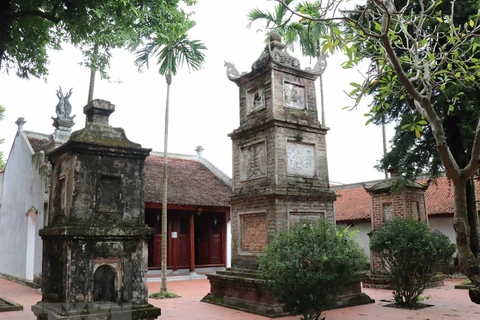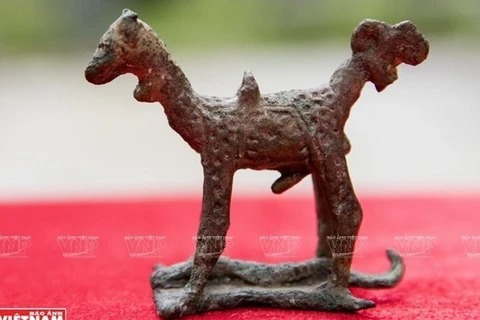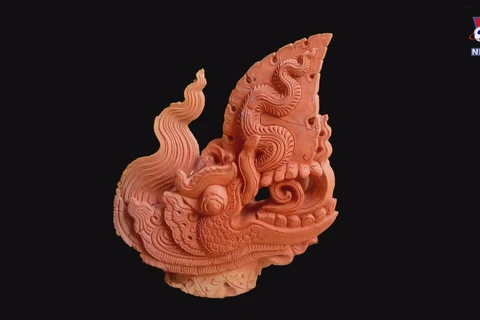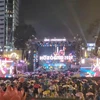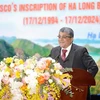 The 115-page book, entitled “9 Bao vat quoc gia o Bao tang My thuat Viet Nam” (9 National Treasures in the Vietnam Fine Arts Museum) (Photo courtesy of the museum)
The 115-page book, entitled “9 Bao vat quoc gia o Bao tang My thuat Viet Nam” (9 National Treasures in the Vietnam Fine Arts Museum) (Photo courtesy of the museum) The 115-page book, entitled “9 Bao vat quoc gia o Bao tang My thuat Viet Nam” (9 National Treasures in the Vietnam Fine Arts Museum) and presented in both English and Vietnamese, introduces the creators and the nine national treasures, including their features and artistic values.
The book will help readers learn about Vietnamese fine arts and the Vietnam Fine Arts Museum collection in particular.
Among them are five artefacts that became national treasures in 2013, including the statue of Quan Am (Bodhisattva Avalokiteshvara) originating from the Hoi Ha Pagoda in Vinh Phuc province, the Statue of Queen Trinh Thi Ngoc Truc originating from Mat Pagoda in Thanh Hóa province, oil painting Em Thuy (Little Sister Thuy) by artist Tran Van Can (1910-1994), the oil painting Hai Thieu Nu vaf Em Be (Two Girls and a Child) by painter To Ngoc Van (1906 - 1954), and a lacquer painting Ket Nap Dang o Dien Bien Phu (Party Admission Ceremony in Dien Bien Phu) by painter Nguyen Sang (1923-1988).
Four artefacts recognised as national treasures in 2017 are a pair of doors carved with dragon motifs of Keo Pagoda in Thai Binh province, lacquer painting Bac Ho o Chien Khu Viet Bac (Uncle Ho in the Viet Bac War Zone) by painter Duong Bich Lien (1924-1988), the standing screen by painter Nguyen Gia Tri (1908 - 1993) and the lacquer painting Saint Giong by artist Nguyen Tu Nghiem (1918-2016).
One of the national treasures featured in the book, the artwork Party Admission Ceremony in Dien Bien Phu Battlefield, was completed by Nguyen Sang in 1963, nine years after the Dien Bien Phu Victory. This year marks 60 years since the painter created the lacquer painting and ten years since it was recognised as a national treasure of Vietnam.
The lacquer painting depicts the Party admission ceremony, which took place on the Dien Bien Battlefield, an important event for each soldier.
According to the book's introduction, Sang spent days living with the soldiers during the anti-French resistance war. He became familiar with their figures, manner and equipment. However, he carefully made many sketches to study the soldier's physique, weapons, and personal belongings before painting them.
Party Admission Ceremony in Dien Bien Phu Battlefield has a tight composition, strong shapes, and bold colours. The painting does not reveal too many techniques, but the bold contrast and ingenious colour transition have showcased a richness of colours and the artistic style of the leading artist of Vietnamese fine arts. It is an epic representation of the Vietnamese revolutionary spirit.
The oldest artefact introduced in the 9 National Treasures in Vietnam Fine Arts Museum is the lacquered wood statue of the Bodhisattva Avalokisteshvara, crafted in the 16th century.
It is divided into three parts: the upper part is the 42-arm Avalokiteshvara sitting on a lotus pedestal; the middle part is a monster holding the lotus pedestal, a dragon head and two attendants Kim Dong, Ngoc Nu; the lower part is a hexagonal pedestal in which is intricately carved with typical motifs.
The statue, 314 x 215 x 155cm and about six tonnes in weight, is one of the most massive and sophisticated ancient sculptures in Vietnam. It is also assessed as an original and unique artefact bearing unique artistic values, typical of Vietnamese Buddhist art.
The book is now available at the museum's shop, La art, located at 66 Nguyen Thai Hoc street, Ba Dinh, Hanoi./.
VNA
